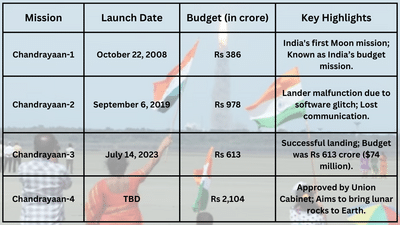The Union cabinet has approved significant expansions to India's space exploration initiatives, including the Chandrayaan-4 mission, Gaganyaan follow-up missions, and the Venus Orbiter Mission .
Speaking on the decisions, Union minister Ashwini Vaishnaw today announced, "Chandrayaan-4 has been expanded with additional elements, and the next step is a manned mission to the Moon. Preparatory steps have been approved. The Venus Orbiter Mission and development of the Next Generation Launch Vehicle have also been greenlit."
Following the success of Chandrayaan-3, the Modi government has allocated Rs 2,104 crore to Chandrayaan-4 that entails bringing lunar rocks and soil to earth, with a mission timeline of 36 months. The mission will consist of two spacecraft stacks featuring five modules. Stack 1 will focus on lunar sample collection , while Stack 2 will handle propulsion, transfer, and re-entry of samples back to Earth.


The mission, set to launch with upgraded LVM-3 rockets , aims to land on the lunar surface, collect samples, and return them to Earth. Chandrayaan-4 will involve complex docking and undocking operations in lunar orbit, marking a significant advancement in India's space capabilities.
In April 2024, ISRO had already outlined plans for Chandrayaan-4, which includes sending two rockets—LVM-3 and PSLV—to facilitate the ambitious mission of returning lunar regolith to Earth.
Speaking on the decisions, Union minister Ashwini Vaishnaw today announced, "Chandrayaan-4 has been expanded with additional elements, and the next step is a manned mission to the Moon. Preparatory steps have been approved. The Venus Orbiter Mission and development of the Next Generation Launch Vehicle have also been greenlit."
Following the success of Chandrayaan-3, the Modi government has allocated Rs 2,104 crore to Chandrayaan-4 that entails bringing lunar rocks and soil to earth, with a mission timeline of 36 months. The mission will consist of two spacecraft stacks featuring five modules. Stack 1 will focus on lunar sample collection , while Stack 2 will handle propulsion, transfer, and re-entry of samples back to Earth.
The mission, set to launch with upgraded LVM-3 rockets , aims to land on the lunar surface, collect samples, and return them to Earth. Chandrayaan-4 will involve complex docking and undocking operations in lunar orbit, marking a significant advancement in India's space capabilities.
#WATCH | On Cabinet decisions, Union Minister Ashwini Vaishnaw says, "Chandrayaan-4 mission has been expanded to add more elements. The next step is to get the manned mission to the Moon. All preparatory steps towards this have been approved. Venus Orbiter Mission, Gaganyaan… pic.twitter.com/ypGFUnW8HS
— ANI (@ANI) September 18, 2024
In April 2024, ISRO had already outlined plans for Chandrayaan-4, which includes sending two rockets—LVM-3 and PSLV—to facilitate the ambitious mission of returning lunar regolith to Earth.
You may also like

Bahrain renews passports of citizens stripped of Kuwaiti nationality following royal directives

Video: Jasmine Crockett says 'crime doesn't make you a criminal'; social media isn't convinced

Navi Mumbai Crime: 38-Year-Old Jewellery Store Driver Arrested For Staging Fake Robbery, Stealing Gold Worth ₹5.9 Lakh In Panvel

Luke Littler releases new video after 'taking a step back from darts' statement

Ashley Barnes father-in-law "conspired" with jockey to stop horse winning, BHA panel rules







